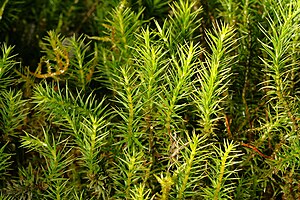Polytrichastrum
| Polytrichastrum | ||||||||||||
|---|---|---|---|---|---|---|---|---|---|---|---|---|

Polytrichastrum formosum |
||||||||||||
| Systematics | ||||||||||||
|
||||||||||||
| Scientific name | ||||||||||||
| Polytrichastrum | ||||||||||||
| GLSm. |
Polytrichastrum is a genus of deciduous mosses from the family Polytrichaceae .
features
The medium-sized to strong plants form loose and often extensive lawns. The ascending to upright, simple or slightly branched stems arise from short underground rhizomes. The leaves consist of a basal, broader, chlorophyll-free sheath that lies against the stem and a narrower, lanceolate and sharply pointed blade. The multilayered leaf vein is very broad and - with the exception of the narrow leaf margins - takes up most of the leaf blade. The upper side of the leaf vein is covered with numerous assimilation lamellae; these are about 5 to 9 cells high.
The actual moss plants (gametophytes) of the genus Polytrichastrum have the same characteristics as those of the genus Polytrichum in the narrower sense; they are distinguished by the characteristics of the sporophytes .
In contrast to Polytrichum species, the spore capsules with a 64-fold peristome are more bluntly four- to six-sided or round, the apophysis (capsule neck) is not sharply separated from the rest of the capsule by a deep constriction. The spores are over 10 µm in size.
distribution
The genus Polytrichastrum has its main distribution area in the cool-temperate to arctic and Antarctic climatic zones, mainly in the northern hemisphere.
Systematics and types (selection)
Polytrichastrum species were formerly part of the genus Polytrichum and were separated by GLSmith in 1971 due to peristome characteristics. According to Stech & Frey, 13 species belong to Polytrichastrum worldwide , of which the following species are represented in Germany, Austria and Switzerland:
- Polytrichastrum alpinum
- Polytrichastrum formosum
- Polytrichastrum longisetum
- Polytrichastrum pallidisetum
- Polytrichastrum sexangulare
swell
- Jan-Peter Frahm , Wolfgang Frey : Moosflora (= UTB . 1250). 4th, revised and expanded edition. Ulmer, Stuttgart 2004, ISBN 3-8252-1250-5 .
- Wolfgang Frey, Michael Stech, Eberhard Fischer: Bryophytes and Seedless Vascular Plants (= Syllabus of Plant Families. 3). 13th edition. Borntraeger, Berlin et al. 2009, ISBN 978-3-443-01063-8 .
- Martin Nebel, Georg Philippi (ed.): The mosses of Baden-Württemberg. Volume 1: General part, special part (Bryophytina I, Andreaeales to Funariales). Ulmer, Stuttgart 2000, ISBN 3-8001-3527-2 .
- Polytrichastrum in www.efloras.org
- JP Frahm: Annotated List of Mosses in Germany (PDF; 226 kB)
- Moss flora in Switzerland
- Checklist of Austria's Mosses ( Memento from November 28, 2012 in the web archive archive.today )